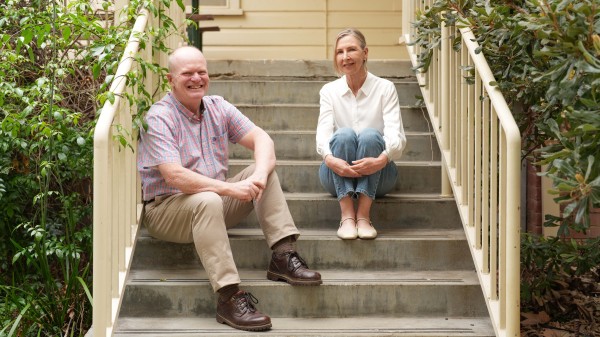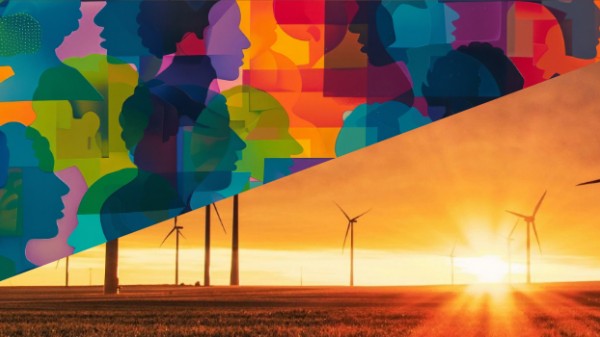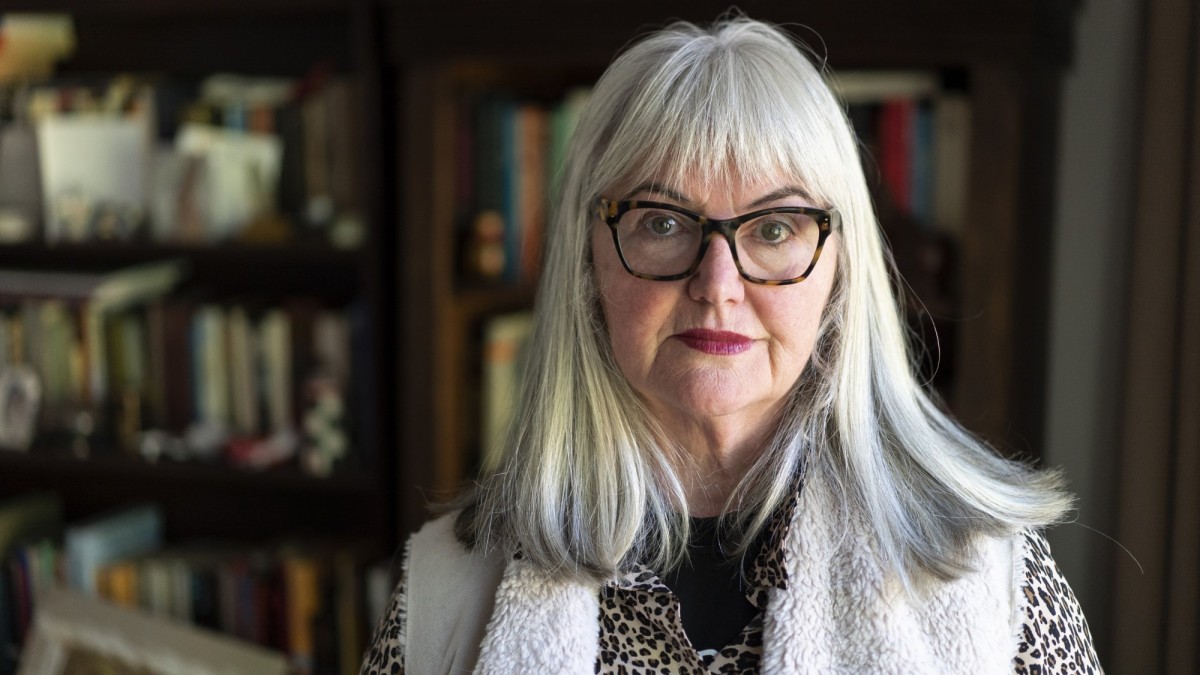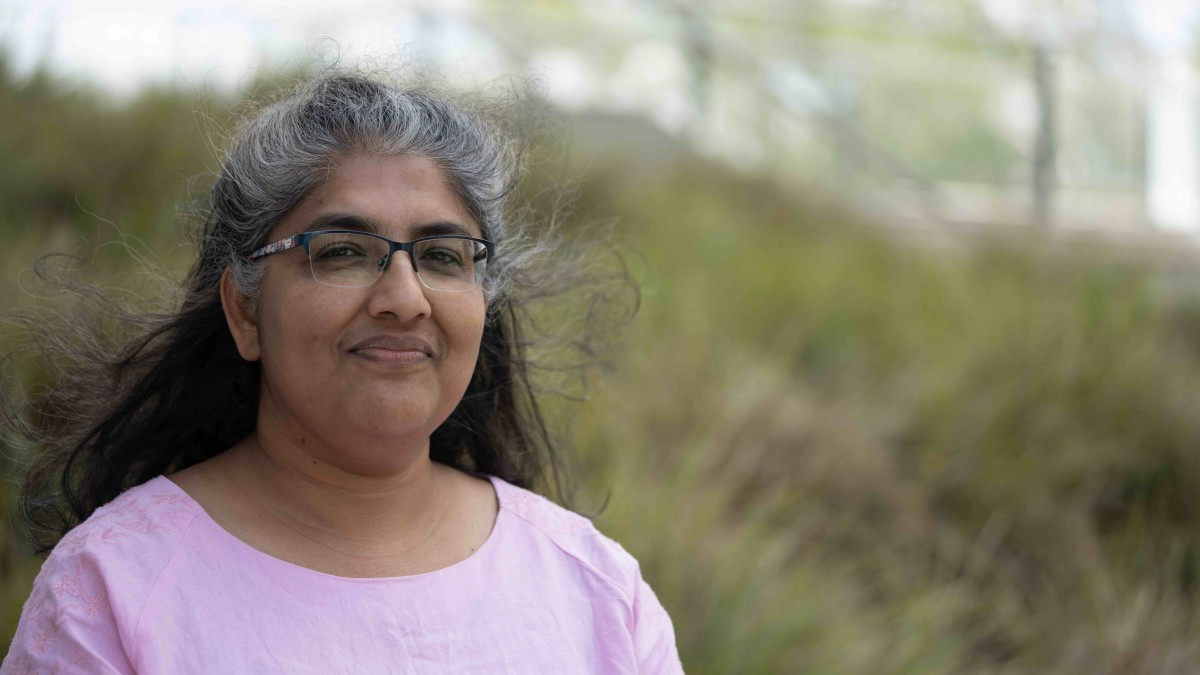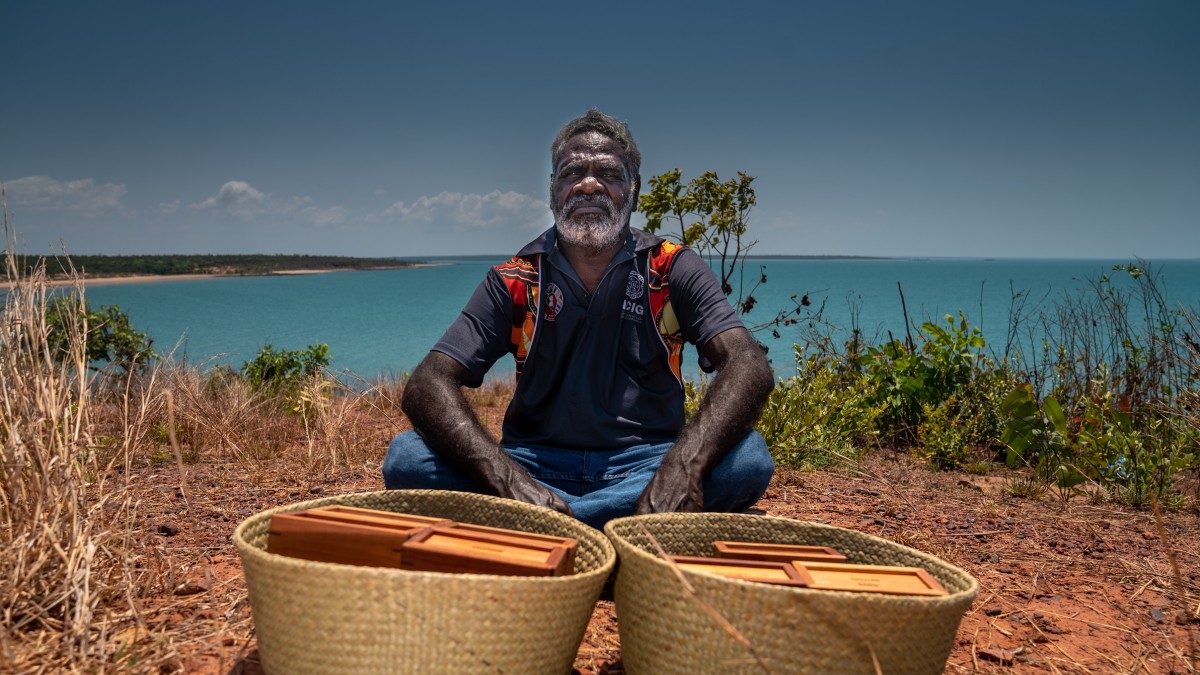Paralysed by climate despair, I’m finding it hard to think about the end of the world and what to make for dinner – but I know where to look for help. My job is to promote the great scientific minds at the Australian National University, so I decide to interview scientists from different fields – the health sector, the human environment, and the climate system – about how to exist in the face of existential dread.
I think it started last summer, when our house became so hot during the heatwave that we spent an entire day in the air conditioning at Belconnen Mall. I mean, the whole day. At around 5pm, flopped on some wipe-down, synthetically upholstered benches outside Kmart, our kids begged to go home.
“Not yet.”
We waited until after dinner, when the air was crackling with lightning, and the temperature finally crawling back into the thirties. We opened the door to our house, a beautiful, light-filled, falling-down classic inner-north rental with no insulation, and only one dawdling ceiling fan for cooling. Standing on our doorstep, engulfed by the heat of the house, I knew we could not continue to live here, not if this summer was the ‘new normal’. The idea of this place as our home was over.
But when I think about it some more, maybe it started when my son was three and deep into his dinosaur phase. “Will humans go extinct too?” he would ask, over and over again, in the way of three-year-olds. “Will the world ever end?”
“Maybe,” I would say. “But in millions and millions of years from now.” The answer never pleased him because his timescale had as its base unit one episode of Thomas the Tank Engine. And how many episodes is that? “More than you could ever watch!” I would say. An impossible idea.
Then there was the heatwave and the bushfires in Tasmania, and the floods in Townsville, and news that all the insects could disappear, and the Great Barrier Reef turned into what looks like a pile of bones on the seafloor. And it didn’t feel so impossible anymore.
And my son, now six, is asking again if humans will go extinct. He’s left behind dinosaurs and moved onto a strange, gothic obsession with abandoned places. He has a book about them, with full-page photos and captions advising the ‘Reason for Abandonment’. He can cite them all: the seaside resort (reclaimed by sand), the theme park (the levees broke), the mine (contaminated), the Caribbean party town (under volcanic ash). I imagine our house in there too (mother said she can’t do another summer here).
He likes abandoned places because they’re spooky. They’re ghost towns. Flipping through the book, he asks, “Could there ever be a whole Earth without humans?” And I say, “Maybe, but not for a long time,” but really I’m thinking: please don’t let it start until the generation after his.
It’s all happening so much sooner than I thought. I did not think that in my lifetime I would be factoring climate change into where I wanted to live, yet now I’ll be doing it before next summer. There’s a Facebook group called the 'Near Term Human Extinction Support Group’. I didn’t think Facebook groups would be there at the end. When Facebook first started, I joined a group called ‘I Heart Dachshunds’. I mean, I still do. But what is it to love a sausage dog at the end of the world?
My son has put aside his book to build a spaceship out of Lego. His little sister is shouting from the bathroom that she needs help to turn the tap on. I have to start making dinner. I forgot to defrost the lasagne. I cannot work out what is worse: the inexorable march to the planet’s destruction, or that in the face of it, I have to make dinner. Defrosting while Rome burns.
My simultaneous hand-wringing and navel-gazing is exhausting, like I’m patting my head and rubbing my tummy, and just as pointless too. The scientists will help me.
“It’s not a matter of life will be really nice, and then we won’t be here anymore,” Dr Liz Hanna says. “It will be a bubbling up of all manner of things.” Dr Hanna is Honorary Senior Fellow at the ANU Climate Change Institute. I ask her what she imagines in a worst-case scenario of the future.
“People will be dying from heat, roads will melt, trainlines will buckle and we won’t be able to get to and from where we need to go. There will be a shortage of water, problems with food supplies, blackouts.”
Dr Aparna Lal, from the ANU Research School of Population Health adds to the picture.
“There will be more extreme weather events, like cyclones, leading to contamination of drinking water by sewage - in parts of the world where kids are already vulnerable from malnutrition. Broader environmental change – like changes in our land use coupled with extreme weather – will increase contact between humans and animals, so you’ll get a much greater chance of bugs spreading between them. Sea levels will come up, threatening the livelihoods and communities of those who have lived on island nations for generations.”
I ask Will Steffen the same question, his worst vision of the future. He is Emeritus Professor at the Fenner School of Environment and Society at ANU, and was also an Australian Government Climate Commissioner, when such a thing existed.
“We’re going to get multiple interacting impacts that are going to affect large groups of people who will not be able to support themselves: rainfall patterns will change so you can’t grow food, extreme weather will be worse, sea levels will come up.
“What do people do in that situation? They move or they fight, or they do both. That’s probably how it’s going to start unravelling. The global system will become increasingly unstable. There will be no-go zones, we will build walls around ourselves and that leads to more instability.”
He pauses.
“A certain amount of this is inevitable. We’ve built many models that show this. Multi-metre sea level rise is already in the system. Locked in.”
My manager asks me how I’m progressing with writing this story. I am finding it increasingly difficult to go on, I say. He thinks I am joking. But no, really, how do we go on?
I used to feel like I was doing something. I was switching over my lightbulbs, cutting meat out of my diet, catching public transport, and printing on both sides of the paper. I felt virtuous. But now it’s clear that these small acts of good citizenry are not working fast enough to make enough of an impact. There’s an urgency I didn’t understand before, a curve on the graph which accelerates under its own momentum. ‘Hothouse Earth’, Professor Steffen and his colleagues called it in a ground-breaking paper.
“If you reach a tipping point in the climate system, like with Hothouse Earth, then you’re not going to be able to stop it,” he says. “The question is: where is that planetary tipping point? That’s the most common question I get now.”
The answer? “We don’t know. In my view, it could be as low as a 1.5-degree temperature rise. I’m pretty sure it’s below three. By the time we hit three, we’re stuffed.”
We are on track for four degrees of warming.
“How do you do it, how do you keep going?" I ask him. I ask all the scientists I speak to. I assume they’ll say they it’s because they have to. They have to have hope. This is why I wanted to speak to them, I think.
I wanted to hear about how science drives them. How they’re dedicating all their resources to finding solutions, to research and innovation. I figured they will say words like ‘renewables’, and ‘negative emissions technologies’, and ‘carbon sinks’ and I will feel relieved. But I will also feel bad because I’m not a scientist and because I forgot to look up what ‘negative emissions technologies’ actually are, and in this state of emergency which requires all hands on-deck, I have nothing to offer the cause. I already feel guilty enough, because I cut out meat but I still eat fish, and my kids really love those plastic collectable bits of crap which the supermarkets give away at the checkouts. I want the scientists to tell me it’s all going to be okay despite this, despite my very existence making their work harder.
But this isn’t what they say.
This story is not turning out how I expected.
Have you been paying attention to the student strikes? I haven’t really. ‘Good on them!’ I thought, seeing the news stories and registering their protests as a powerful symbol, but a symbol only.
Scientists have been paying attention, though.
“The problem we’re facing, it’s not a technology problem. It’s not a science problem,” Professor Steffen explains. “It’s a problem with the human side of things, with our socio-political values.”
And so it follows that their hope doesn’t reside in scientific innovation; it’s in humans – even after all we’ve done! In answer to the question of how they go on, the scientists all say the same thing: because of the students.
The students! This is not the answer I came to hear, because unlike a scientist, I’m not good at projections. I only saw the students as they appear now – marginal, symbolic – and not what they will be.
“The neoliberal economic system we’ve bought into is completely at odds with how the Earth works,” Professor Steffen continues. “We have to change this value system that we operate under. We need a social tipping point that flips our thinking, before we reach a tipping point in the climate system.
“I think Greta Thunberg could turn out to be that tipping element.”
But Greta, the sixteen year-old Swedish activist, hasn’t made a dent on the problem, I say.
“Not yet,” Steffen says. “The thing about a complex system, like our societies, is they are hard to predict because they’re highly non-linear. It’s not simple cause and effect. The state of the system – that is, the neoliberal economic system and our use of fossil fuels – seems so set, so stable, so tough, that nothing’s going to affect it. But it’s getting eroded from underneath - by the students, by legal battles, by increasing extreme weather events.
“Where you have a lot of people waking up and saying, ‘Something isn’t right’, that could be the kind of fundamental thing we need to reach the tipping point. It’s not just the students. I think more people are beginning to sense that too. For the first time, I’m seeing old white men in the bush saying something is changing there too.
“I’m not saying we’re now going to solve climate change but I’m saying we are getting to a point where reaching that kind of social tipping point is our only hope. The solutions are already there. It’s the system that’s preventing it.”
Dr Hanna’s face lights up when she describes what she saw at the student strikes at Garema Place. But it’s so… soft, I say.
She shakes her head. “No, no. Not at all.”
“Nobody can argue against their moral authority. They deserve a future and an inhabitable planet. Nobody has a right to deprive them of that and it should be treated like social leprosy to act otherwise.
“These people who claim to care about their grandchildren…” she trails off, and starts again.
“We should be raising climate change as a topic of conversation with everyone we can. Just say a little something to promote empathy and compassion and to get rid of this mentality of ‘I’m alright Jack, bugger the rest of you’. We can hope they’ll then say a little something to someone else and the residual dinosaurs will eventually realise they’re out of step and it’s not socially acceptable to behave that way anymore.”
“The more we talk about it, the more mainstream it can become, as part of our thinking and culture,” Dr Lal says. “That’s why these climate strikes are really cool. I know people who have never talked about climate change, talking about it because of the students.”
“I have personally found one of the most effective ways to bring about behaviour change is to go into school and the kids take that information home,” Dr Lal continues. “Parents are much more receptive to hearing those messages from their kids than from me.”
“Messages like what?” I ask. “Resilience in the face of climate change,” she says. “Like how to survive the apocalypse?” I ask.
“No!” she laughs. “I mean psychosocial resilience. Teaching them to be aware of their surroundings, to be empathetic, to think about a life outside their own. Take them into the bush, take them on a road trip to see rural and remote Australia.”
“We need to make sure the kids reattach to the biosphere and the living world,” Professor Steffen says. “Get a dog! When I walk my dog around Canberra, the number of the toddlers who are innately attracted to that little dog is incredible. It’s innate to us. We’ve got to keep that. Take the kids out to the bush. Take them to protests.”
Go for a bushwalk? Get a dog? In my mind, roads were already buckling and train tracks were already melting, and only massive changes at the highest level would have any impact. So I was looking for a way to live which felt commensurate with the end of the world. I was thinking about survival skills, I was planning last-gasp trips to the Great Barrier Reef, I was trying to protect my son from the gnawing truth of his imminent demise. To do otherwise, to just go on existing, didn’t seem appropriate in an existential crisis.
But going on is not the problem, it’s the solution. It’s the way the seeds are sown for change. It’s our every day. It’s the way we raise our children, it’s in the conversations we have with our neighbours, it’s in our connection to the landscape and to each other and to our dog. It’s in our votes.
This, I can do, and make dinner.
I take the kids to the Vote Climate protest. There are a lot of speeches, but there’s also someone dressed as a jellyfish, and my kids are impressed with that. In one of the speeches, the writer Richard Flanagan, talking about the fight to save the Franklin River, says the same thing which I had just heard Professor Steffen say. It’s uncanny:
“At every step it looked like we had lost, and yet, what we could not see was that at every stop we were growing stronger…. These things happen because at a certain point enough people say there are things that matter more than politics or money. There is no power on this Earth that can resist an idea whose time has come.”
Has everyone been saying this all along, and only now I’m open to noticing it? Or is there something building, a rumbling which the scientists heard first, because they always seem to know what’s going to happen next?
My son listens half-heartedly to all the speakers, while fiddling with bits of grass in his lap. Someone mentions the words “sixth mass extinction” and his head snaps up to pay attention. He then leans over and asks if I have any snacks in my bag. We go on.
I think of what Dr Hanna said when I asked her about my son’s questions, about the end of the world.
“That’s a fair and reasonable question,” she said. “You can’t give kids, as Greta says, false hope. You have to highlight that we’re at a fork in the road: the road that’s got us here is the road to ruin, and we’re working to make it better.”
Thankfully, we go on.






